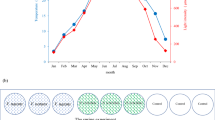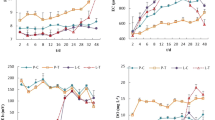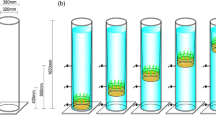Abstract
The response of periphyton biofilm and the submerged macrophyte tape grass (Vallisneria natans) to internal loading from eutrophic lake sediments were evaluated in microcosms. The sediments from the littoral zone and center of a lake were selected to carry out the microcosm experiment. To determine how the differences in the periphyton biofilm and V. natans growth alone or in combination, we measured changes in water quality, growth, and TP in the periphyton biofilm and V. natans in microcosms containing these sediments. The results showed that the average daily TN and TP removal rates were 32.6 and 35.4%, respectively, in the microcosms containing the lake center sediments by V. natans and the periphyton biofilm. The presence of the periphyton biofilm and V. natans increased the pH, dissolved oxygen, and redox potential and decreased the conductivity in the overlying water in all treatments. Compared to the state before the treatments, V. natans grew well, with a significant increase in biomass (3.1- to 5.5-fold growth) and TP amount (5.1- to 8.8-fold) in all treatments after 48 days. However, the growth of V. natans that combined with the periphyton biofilm was better than that of V. natans alone, as reflected by the dry weight, chlorophyll a content, malondialdehyde content, and TP amount. In conclusion, the periphyton biofilm was beneficial for the growth of V. natans, and the appropriate combination of V. natans and periphyton biofilm would be a potential method for the ecological restoration of eutrophic lakes.





Similar content being viewed by others
References
APHA (2002) Standard methods for the evaluation of water and wastewater, 22nd edn. American Public Health Association, Washington
Borovec J, Sirová D, Mošnerová P, Rejmánková E, Vrba J (2010) Spatial and temporal changes in phosphorus partitioning within a freshwater cyanobacterial mat community. Biogeochemistry 101(1–3):323–333
Cao J, Hong X, Pei G (2014) Removal and retention of phosphorus by periphyton from wastewater with high organic load. Water Sci Technol 70(1):62–69
Chen RL, Barko JW (1988) Effects of freshwater macrophytes on sediment chemistry. J Freshw Ecol 4(3):279–289
Christenson LB, Sims RC (2012) Rotating algal biofilm reactor and spool harvester for wastewater treatment with biofuels by-products. Biotechnol Bioeng 109(7):1674–1684
Christophoridis C, Fytianos K (2006) Conditions affecting the release of phosphorus from surface lake sediments. J Environ Qual 35(4):1181–1192. https://doi.org/10.2134/jeq2005.0213
Dittricha M, Gabrielb O, Rutzenc C, Koscheld R (2011) Lake restoration by hypolimnetic Ca(OH)2 treatment: impact on phosphorus sedimentation and release from sediment. Sci Total Environ 409(8):1504–1515. https://doi.org/10.1016/j.scitotenv.2011.01.006
Dodds WK (2003) The role of periphyton in phosphorus retention in shallow freshwater aquatic systems. J Phycol 39(5):840–849
Gette-Bouvarot M, Mermillod-Blondin F, Lemoine D, Delolme C, Danjean M, Etienne L, Volatier L (2015) The potential control of benthic biofilm growth by macrophytes—a mesocosm approach. Ecol Eng 75:178–186
Han H, Chen Y, Jørgensen SE, Nielsen SN, Hu W (2009) A system-dynamic model on the competitive growth between Potamogeton malaianus Miq. and Spirogyra sp. Ecol Model 220(18):2206–2217
He S, Gang X (2010) Algal-based immobilization process to treat the effluent from a secondary wastewater treatment plant (WWTP). J Hazard Mater 178(1–3):895–899
Heath RL, Packer L (1968) Photoperoxidation in isolated chloroplasts. I. kinetics and stoichiometry of fatty acid peroxidation. Arch Biochem Biophys 125(1):189–198
Hunter PJ, Teakle GR, Bending GD (2014) Root traits and microbial community interactions in relation to phosphorus availability and acquisition, with particular reference to Brassica. Front Plant Sci 5(5):27
Jarvie HP, Jürgens MD, Williams RJ, Neal C, Davies JJL, Barrett C, White J (2005) Role of river bed sediments as sources and sinks of phosphorus across two major eutrophic UK river basins: the Hampshire Avon and Herefordshire Wye. J Hydrol 304(1–4):51–74
Jaynes ML, Carpenter SR (1986) Effects of vascular and nonvascular macrophytes on sediment redox and solute dynamics. Ecology 67(4):875–882
Jin X, Jiang X, Yao Y, Li L, Wu FC (2006) Effects of light and oxygen on the uptake and distribution of phosphorus at the sediment–water interface. Sci Total Environ 357(1–3):231–236
Johnson MB, Wen Z (2010) Development of an attached microalgal growth system for biofuel production. Appl Microbiol Biotechnol 85(3):525–534
Kesaano M, Sims RC (2014) Algal biofilm based technology for wastewater treatment. Algal Res 5(1):231–240
Liu J, Liu W, Wang F, Kerr P, Wu Y (2016) Redox zones stratification and the microbial community characteristics in a periphyton bioreactor. Bioresour Technol 204:114
Lu H, Yang L, Shabbir S, Wu Y (2014) The adsorption process during inorganic phosphorus removal by cultured periphyton. Environ Sci Pollut Res 21(14):8782–8791
Lu H, Feng Y, Wang J, Wu Y, Shao H, Yang L (2016a) Responses of periphyton morphology, structure, and function to extreme nutrient loading ☆. Environ Pollut 214:878–884
Lu H, Wan J, Li J, Shao H, Wu Y (2016b) Periphytic biofilm: a buffer for phosphorus precipitation and release between sediments and water. Chemosphere 144(2016):2058–2064. https://doi.org/10.1016/j.chemosphere.2015.10.129
Maberly SC, Dhn S (1983) Photosynthetic inorganic carbon use by freshwater plants. J Ecol 71(3):705–724
Mccormick PV, Iii RBES, Chimney MJ (2006) Periphyton as a potential phosphorus sink in the Everglades Nutrient Removal Project. Ecol Eng 27(4):279–289
Meagher RB (2000) Phytoremediation of toxic elemental and organic pollutants. Curr Opin Plant Biol 3(2):153–162
Nixon SW (2009) Eutrophication and the macroscope. Hydrobiologia 629(1):5–19
Pei G, Wang Q, Liu G (2015) The role of periphyton in phosphorus retention in shallow lakes with different trophic status, China. Aquat Bot 125:17–22
Robe WE, Griffiths H (2000) Physiological and photosynthetic plasticity in the amphibious, freshwater plant, Littorella uniflora, during the transition from aquatic to dry terrestrial environments. Plant Cell Environ 23(10):1041–1054
Roberts E, Kroker J, Körner S, Nicklisch A (2003) The role of periphyton during the re-colonization of a shallow lake with submerged macrophytes. Hydrobiologia 506–509(1–3):525–530
Ruban V, López-Sánchez JF, Pardo P, Rauret G, Muntau H, Quevauviller P (2001) Harmonized protocol and certified reference material for the determination of extractable contents of phosphorus in freshwater sediments—a synthesis of recent works. Fresenius J Anal Chem 370(370):224–228
Sagrario MAG, Jeppesen E, Gomà J, Søndergaard M, Jensen JP, Lauridsen T, Landkildehus F (2005) Does high nitrogen loading prevent clear-water conditions in shallow lakes at moderately high phosphorus concentrations? Freshw Biol 50(1):27–41
Shangguan H, Liu J, Yan Z, Tong Z, Wu Y (2015) Start-up of a spiral periphyton bioreactor (SPR) for removal of COD and the characteristics of the associated microbial community. Bioresour Technol 193(10):456–462
Singh R, Tripathi RD, Dwivedi S, Kumar A, Trivedi PK, Chakrabarty D (2010) Lead bioaccumulation potential of an aquatic macrophyte Najas indica are related to antioxidant system. Bioresour Technol 101(9):3025–3032
Stumm W, Morgan JJ (1996) Aquatic chemistry: chemical equilibria and rates in natural waters, 3rd edn. Wiley, New York
Su S, Zhou Y, Qin JG, Wang W, Yao W, Song L (2011) Physiological responses of Egeria densa to high ammonium concentration and nitrogen deficiency. Chemosphere 86(5):538–545
Tang X, Wu M, Dai X, Chai P (2014) Phosphorus storage dynamics and adsorption characteristics for sediment from a drinking water source reservoir and its relation with sediment compositions. Ecol Eng 64(3):276–284
Wang S, Jin X, Pang Y, Zhao H, Zhou X, Wu F (2005) Phosphorus fractions and phosphate sorption characteristics in relation to the sediment compositions of shallow lakes in the middle and lower reaches of Yangtze River region, China. J Colloid Interface Sci 289(2):339–346
Wang S, Jin X, Bu Q, Jiao L, Wu F (2008) Effects of dissolved oxygen supply level on phosphorus release from lake sediments. Colloids Surf A Physicochem Eng Asp 316(1–3):245–252
Wang C, Sun Q, Wang L (2009) Cadmium toxicity and phytochelatin production in a rooted-submerged macrophyte Vallisneria spiralis exposed to low concentrations of cadmium. Environ Toxicol 24(3):271–278. https://doi.org/10.1002/tox.20429
Wang S, Jiao LX, Yang S, Jin X, Yi W (2012) Effects of organic matter and submerged macrophytes on variations of alkaline phosphatase activity and phosphorus fractions in lake sediment. J Environ Manag 113(1):355–360
Wang H et al (2013) Phosphorus fluxes at the sediment–water interface in subtropical wetlands subjected to experimental warming: a microcosm study. Chemosphere 90(6):1794–1804
Wang G et al (2015) A new potential secretion pathway for recombinant proteins in Bacillus subtilis. Microb Cell Factories 14(1):1–7
Wei LI, Zhang Z, Jeppesen E (2008) The response of Vallisneria spinulosa (Hydrocharitaceae) to different loadings of ammonia and nitrate at moderate phosphorus concentration: a mesocosm approach. Freshw Biol 53(11):2321–2330
Wigand C, Wehr J, Limburg K, Gorham B, Longergan S, Findlay S (2000) Effect of Vallisneria americana (L.) on community structure and ecosystem function in lake mesocosms. Hydrobiologia 418(1):137–146
Wu Y, Zhang S, Zhao H, Yang L (2010) Environmentally benign periphyton bioreactors for controlling cyanobacterial growth. Bioresour Technol 101(24):9681–9687. https://doi.org/10.1016/j.biortech.2010.07.063
Wu Y, Li T, Yang L (2012) Mechanisms of removing pollutants from aqueous solutions by microorganisms and their aggregates: a review. Bioresour Technol 107:10–18. https://doi.org/10.1016/j.biortech.2011.12.088
Yu Q, Wang HZ, Li Y, Shao JC, Liang XM, Jeppesen E, Wang HJ (2015) Effects of high nitrogen concentrations on the growth of submersed macrophytes at moderate phosphorus concentrations. Water Res 83:385–395
Zaman T, Asaeda T (2013) Effects of NH4–N concentrations and gradient redox level on growth and allied biochemical parameters of Elodea nuttallii (Planch). Flora 208(3):211–219
Zhang Y, He F, Xia S, Zhou Q, Wu Z (2015) Studies on the treatment efficiency of sediment phosphorus with a combined technology of PCFM and submerged macrophytes. Environ Pollut 206:705–711. https://doi.org/10.1016/j.envpol.2015.08.018
Zhang Y et al (2016) In-situ adsorption-biological combined technology treating sediment phosphorus in all fractions. Sci Rep 6:29725
Funding
This research was supported by the National Science Foundation of China (Grant No 30970550) and Hubei Province (2015CFB416).
Author information
Authors and Affiliations
Corresponding author
Ethics declarations
Conflict of interest
The authors declare that they have no conflict of interest.
Additional information
Responsible editor: Boqiang Qin
Rights and permissions
About this article
Cite this article
Yang, Y., Chen, W., Yi, Z. et al. The integrative effect of periphyton biofilm and tape grass (Vallisneria natans) on internal loading of shallow eutrophic lakes. Environ Sci Pollut Res 25, 1773–1783 (2018). https://doi.org/10.1007/s11356-017-0623-9
Received:
Accepted:
Published:
Issue Date:
DOI: https://doi.org/10.1007/s11356-017-0623-9




